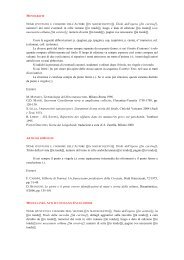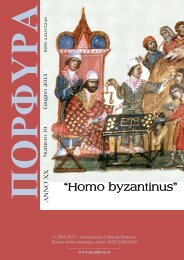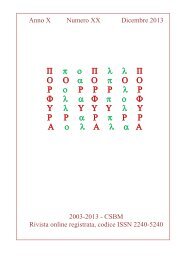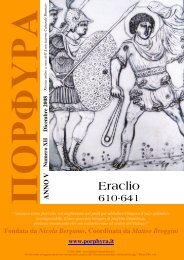ΠΟΡΦΥΡΑ - Porphyra
ΠΟΡΦΥΡΑ - Porphyra
ΠΟΡΦΥΡΑ - Porphyra
Create successful ePaper yourself
Turn your PDF publications into a flip-book with our unique Google optimized e-Paper software.
A Prôtospatharios, Magistros, and Strategos Autokrator of 11 th cent.<br />
the equipment of Georgios Maniakes and his army according to the Skylitzes Matritensis miniatures<br />
and other artistic sources of the middle Byzantine period.<br />
by all the people who was accustomed to come to blows 313 .<br />
The man wears two tunics: a light undergarment, probably a<br />
καµισιον 314 , in a ochre dyed linen, and a superior cotton, felt or<br />
silk garment, who could be the identified with the so called<br />
armilausion, 315 or a kind of padded himation worn under<br />
armour. Under the cuirass the soldiers wore special garments, to<br />
prevent the body from the direct contact with iron or other<br />
coarse materials or armour and to make it easier to wear it. So at<br />
least you could deduce from the text of Anonymus de re militari<br />
of 6 th cent., which can be applied to later ages. He says that an<br />
important factor for the equipment’s effectiveness should be its<br />
distance from the body: "It should not be worn directly over<br />
ordinary clothing, as some do to keep down the weight of the<br />
armour, but over a himation at least a finger thick. There are<br />
two reasons for this. Where it touches the body the hard metal<br />
may not chafe but may fit and lie comfortably upon the body. In<br />
addition, it helps to prevent the enemy missiles from hitting the<br />
flesh because of the iron, the design, and the smoothness, but<br />
also because the metal is kept away from the flash."(Anonymus<br />
Peri Strategias, 16, 20-27) 316 . Under-garments of this kind<br />
(ιµατια) formed a heavier weight for the soldiers, but protected<br />
them from wounds caused by their armour and offered a more<br />
consistent protection. Furthermore these undergarments were<br />
not only worn under the metal armour, but also, as in this way,<br />
under the leather fabric of the lamellae, so that their defensive<br />
function takes on a bigger importance.<br />
We know from tacticians 317 that in 10-11 th centuries the<br />
Roman infantrymen wore padded tunics made of felt, cotton or<br />
coarse silk; the καβαδια of the infantry are recorded as wearing<br />
an outer protective layer 318 , over the armour or even instead of<br />
it, but this does not exclude that under cuirass tunics, made as<br />
well of padded material or kentoukla, 319 were worn under the<br />
armour as shown in the pictorial sources.<br />
We should verify if the padded tunic under armour here worn<br />
is to identify with the kind of tunic called αρµιλαυσιον. The<br />
use of this tunic by the infantrymen in Roman army is attested<br />
313<br />
S. Pio Franchi de Cavalieri, Il Menologio, folio 3 (Joshua) p. 4.note 3; for other examples of mantle rolled up the<br />
body in 10-11 th cent. Byzantium s. the Joshua Roll, in Heath, Byzantine Armies, p.5,28,30; the Goliath in Cod. Gr. 17<br />
of Marciana, in idem, p.37.<br />
314<br />
About καµισιον s. note 138 above.<br />
315<br />
De Cer. II, 670; s. Reiske Commentarii pp. 341, 792-793; Du Cange, Glossarium, col. 123 : “...a men wearing a<br />
yellow- red-scarlet armelausion, quadrangolar and padded...” Cfr. Martyrium S. Bonifatii and Paulinus, Ep. XVII, 1,<br />
“...cum armilausa ruberet...” in Pio Franchi de Cavalieri, Come andavano vestiti ed armati i milites, p. 225 n.3 . In De<br />
Cer. I, 352 this dress is mentioned for the charioters of the factions in cyrcus, who should have a padded dress.<br />
316<br />
Translation of Dennis, in Three Treatises, p. 55.<br />
317<br />
Nikephoros Phokas, Praecepta Militaria, I, 3; Nikephoros Ouranos, Taktika, 56, 3; Sylloge Tacticorum, 38, 4 ;<br />
38,7;<br />
318<br />
On the argument s. also the interesting article of Walker G., Byzantine military coats, in Varangian Voice 45, pp.<br />
17-21<br />
319 See also Kolias, Waffen, pp. 54-55 and note 136 ;<br />
50

















